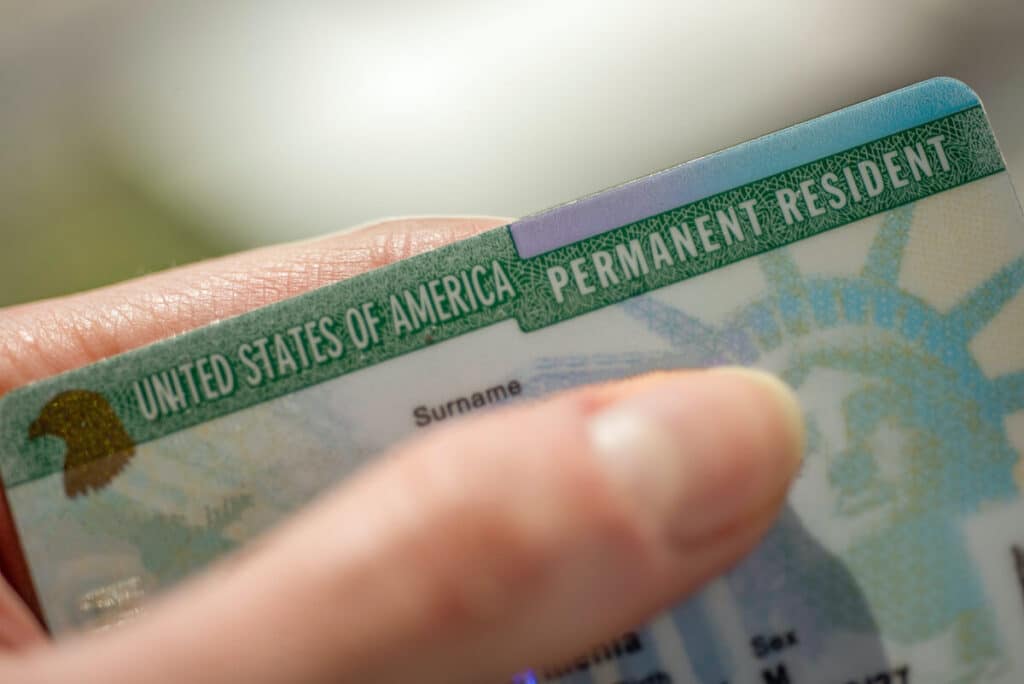Achieving a green card is a dream come true for countless individuals on their journey to becoming a U.S. citizen. A green card lets you legally live and work in the United States, allowing you to take advantage of the many opportunities available in the country.
But how you get your green card depends on your unique situation, so it pays to learn everything possible before starting the process with U.S. Citizenship and Immigration Services (USCIS). Here are the details you should know to learn how to get a green card in the United States.
Green card eligibility categories
Knowing the eligibility category you fall under is the first step to determining the next steps for getting your green card. The seven green card categories below outline the most common requirements when applying.
Family
If you have family members legally living in the United States, you’re eligible for a family-based green card. You can apply for a green card through your family if you have parents, siblings, children, or a spouse of a U.S. citizen living in the country. To apply for a green card through your family, you need to complete a “Green Card Petition for Alien Relative.” This formal request is made to the U.S. government to grant a green card to a foreign national who is a close relative of a U.S. citizen or lawful permanent resident.
Employment
Immigrants moving to the United States for work can apply for a green card by getting a sponsorship from a U.S. employer. Immigrants applying for a green card because of employment will need to select the proper visa based on their skill set, occupation, and employment history.
Immigrants applying for a green card through employment must select the appropriate visa based on their skill set, occupation, and employment history. For those with exceptional ability or extraordinary ability, there are specific visa categories that cater to highly skilled individuals, such as the EB-1A visa for individuals with extraordinary ability or achievement.
Additionally, if you need work authorization while your green card application is processed, you can apply for an Employment Authorization Document (EAD).
Refugee or asylee
If you’re a refugee or asylum seeker, you’re eligible to apply for a green card. You must have had your status for at least one year before applying.
Human trafficking and crime victims
Victims of human trafficking and crime are eligible to apply for green cards, depending on their current status in the United States. Human trafficking victims need a T non-immigrant visa, while crime victims require a U non-immigrant visa, also known as a U-visa.
Victim of abuse
A victim of abuse caused by a legal resident of the United States can apply for a green card. These individuals include parents, children, and spouses of U.S. citizens.
Registry
Residents of the United States who have lived in the country for an extended period can apply for green cards. Registry applicants are those who entered the United States before 1972, lived there continuously, and have stayed out of trouble with the law.
Diversity visa lottery
The diversity visa lottery is for people wishing to immigrate to the United States from countries with low immigration rates to the U.S.
The lottery requires candidates to have a high school degree or relevant work experience and allows 50,000 people to apply for green cards yearly.
How to apply for a green card
Once you determine your eligibility for a green card, you’re ready to start the application process. Here are the steps to take to get started.
1. Get a sponsor
Most of the time, you can’t file for a green card on your own, so you need a sponsor to file the form for you. Here are the common situations when you’ll have a sponsor:
- You have an immediate relative in the country
- You’re getting married to your partner and need a marriage-based green card
- You have an employment opportunity and need a company to sponsor you
In these cases, your sponsor must also provide an affidavit of support, a legal commitment to support you financially.
There are other cases when you can file for a green card on your own. Some common cases for this are immigration petitions for asylum and refugee status.
Once you file your petition for a green card, you’ll wait to hear if visas are available in your category. You can’t continue the process until a visa becomes available.
2. Complete the application
After the government approves your application, you’ll need to fill out a green card application. The form you need depends on your current location.
If you already legally live in the United States, you’ll use Form I-485. If you’re applying to be a lawful permanent resident, you must also fill out Form I-485 Supplement A.
Form DS-260 is for applicants who live abroad during the application process. People who file Form DS-260 must go through consulate processing at a United States embassy or use the online portal once they receive approval.
A special note for applicants with a conditional green card: a conditional green card is valid for two years. To transition to permanent resident status without conditions and receive a permanent resident card, you must apply to remove the conditions before your two-year period expires.

3. Go to your biometrics appointment
The U.S. government requires immigrants to provide their biometric information before offering them a green card. This includes providing your photo, signature, and fingerprints. The government uses these items to conduct background checks before moving you to the next step of the application process.
4. Set up an interview
Once you submit your biometric information to immigration services, your next goal is to set up the naturalization interview. This interview will cover your background, educational history, and other parts of your application.
Besides questions about your background, you’ll be tested on your English abilities and civics.
5. Receive your application decision
It’s a waiting game after your interview process. Continue your normal life until you hear from immigration services about your application status.
How long does it take to get a green card?
The green card processing time isn’t quick. Almost every eligibility category has yearly limits on the number of people allowed in, so the time it takes can vary. Adjusting status can take anywhere from seven months to ten years.
Additionally, if you are applying for a green card through adjustment of status from within the United States, your current status and the specific visa category may affect the processing time.
If you are outside the U.S., you can use consular processing by applying for an immigrant visa at a U.S. Department of State consulate abroad to enter the U.S. as a permanent resident.
How to check your case status
Checking your case status is a simple process.
Your first option is to check online. Visit the immigration case website and enter your receipt number to get an updated status.
You may also call the USCIS Contact Center to speak with an immigration official to get an update. Their number as of this writing is 800-375-5283.
Furthermore, the Visa Bulletin is a monthly publication from the U.S. Department of State that provides information about visa availability.
How to renew a green card
Green cards expire after ten years.
To renew a green card:
- Complete the Form I-90 renewal application online or fill out a physical form;
- Gather supporting documents;
- Pay the green card renewal fee; and
- Submit your application online or by mail.
If you have any issues with your renewal, such as not meeting residency requirements or other complications, you may need to apply for a waiver.
It can take a long time to process your application, so don’t wait too long to start the renewal process. It’s smart to start the renewal process six months before the expiration date to give yourself time to deal with unexpected situations.
How to replace your green card
You need your U.S. green card to prove you can legally live and work in the United States. If you lose or destroy your card, you’ll need to get a replacement as soon as possible.
Getting a replacement green card is similar to renewing one. You fill out Form I-90, submit the required evidence, pay the fees, and submit your application. Also, if you change your address, you will have to report it and update your green card accordingly.
Resources for green card applicants
The green card application process can be overwhelming. These organizations support applicants in various ways. Contact a local chapter to find out more:

Staying safe and avoiding errors
The immigration process has a lot of complexity. Watch out for these stumbling blocks.
Green card scams
Unfortunately, these scams take advantage of immigrants trying to get their green cards. Watch out for:
- Suspicious emails offering dream job opportunities
- People pretending to be government officials
- Requests for phone and email payments
- Demands for payment for immigration support
Use the right sponsor and petition forms
You’ll use Form 485 or DS 260 to apply for your green card, but the sponsor forms differ based on your needs. They will vary based on the type of sponsorship you’re getting.
Take a marriage green card, for instance. You need to verify the marriage with your spouse with Form I-130. This form is also helpful if you have immediate family members you wish to sponsor.
However, employment-based immigration requires your employer to file Form I-140. Keep an eye out for these details.
Apply for the correct work visa
If applying for work sponsorship, choose the right type for your situation.
Take a first preference employment-based (EB) worker, for instance. Individuals highly skilled in the sciences, arts, and other industries can apply for an EB-1 visa. However, the other four EB visas cover distinct skill sets.
In all work visa cases, examine the requirements for each one and apply for the visa that matches your skills.
An immigration lawyer can play a crucial role in helping you become a green card holder by guiding you through the difficulties of immigration law. The right law firm or immigration attorney can provide personalized legal advice. They can also help you navigate USCIS and ensure that all your documentation is correctly prepared.
If you’re sending money back home to friends and family, Remitly can help. We make international money transfers faster, easier, and more affordable. Download the Remitly app to get started with a free account.
